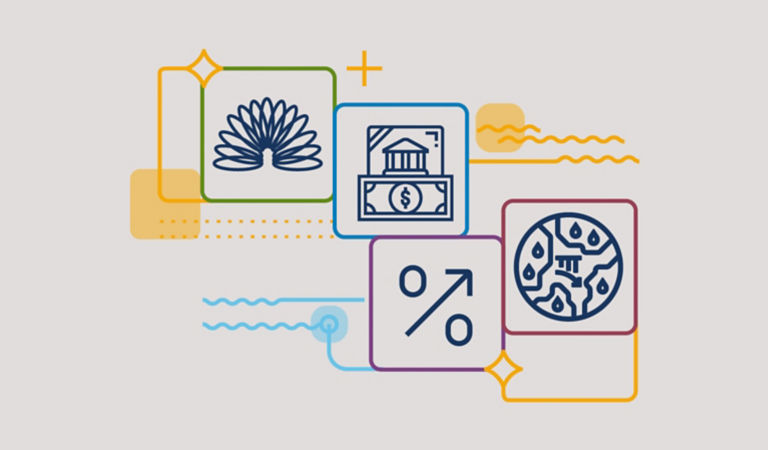Inflation appears to be cooling globally, with the multi-decade-high reads of 2022 now firmly in the rearview mirror. While there could, of course, be upside surprises such as commodities shocks, idiosyncratic events, or prolonged consumer resilience, we believe global inflation is trending firmly downward. Based on current pricing, we think a soft landing is the most likely outcome. That said, a sudden reacceleration in the economic data or increasing inflation that could surprise market participants cannot be excluded altogether, given strong corporate and consumer balance sheets as well as remarkably tight labor markets.
The more likely scenario, however, is that markets are correctly pricing in rate cuts. With inflation moving lower and real interest rates much higher compared to a year ago despite the recent rally, central banks have room to manoeuvre and will want to avoid monetary policy becoming too restrictive. The return of the trade-off between inflation and growth has caused policymakers to worry about the downside risks for the economic cycle, arguably at least as much as they do about the risk that inflation does not return to target.
US and Europe potentially diverging
Given this growing concern about avoiding a deep recession, we believe central banks may take weak economic growth (or a recession, no matter how shallow) as a cue to cut rates, particularly as monetary policy appears to be achieving its objective of bringing inflation sustainably down toward 2%. While the first half of the year may see the US Federal Reserve (Fed) setting the trend for cuts among global central banks, we could witness growing divergence between countries later in the year.
The Fed has likely already reached its terminal policy rate and may begin rate cuts in the first quarter of 2024 as economic data likely weakens further and before the presidential election cycle gets in full swing. With inflation likely to remain above the Fed’s 2% target during that period, consumers will by then feel the pain — with elevated inflation having eroded real wages further and precautionary savings largely spent — amid rising unemployment and tighter credit conditions. The Fed will therefore likely demonstrate a tolerance for above-target inflation, since failing to do so (and increasing policy rates further) would risk tipping the economy into a more severe recession.
Europe has experienced a persistent drop in inflation over the course of 2023, albeit to a lesser degree in the UK. Growth has flatlined and some countries — most notably Germany — are flirting with a technical recession. Consumer spending has not kept pace with the US over the last few years and COVID savings are unlikely to suddenly be spent. However, core inflation is likely to stay above target, thanks to a very resilient jobs market and only a slight uptick in unemployment. Despite significant rate hikes, the last mile in getting inflation back to 2% is going to be harder than the path trodden so far, as the manufacturing cycle appears to have troughed and services could pick up. In this context, while markets are pricing in rate cuts, we could, in fact, see the European Central Bank keep rates where they are unless there is significant deterioration in labor markets. The Bank of England may also be forced to pause after a few cuts. Maintaining rates at these higher levels would be a sign that:
- economies appear able to withstand higher rates without entering a significant recession;
- cycles across countries can remain unsynchronised; and
- barring exogenous shocks, the years of zero-lower-bound rates are behind us.
We expect a continuation of the steepening trend, either through rallies at the front end or through moves up in long-end yields as economies withstand more persistent inflation in the long term.
Japan remains the exception
The notable exception to cooling inflation in developed countries is Japan, which is seeing significant reflation as the Bank of Japan (BOJ) has been unfazed in shifting away from accommodative policies at its own pace, rather than joining global central banks in their hiking cycles. While yield curve control has been significantly adjusted, we will still start 2024 with negative BOJ rates and markets having so far been unsuccessful in putting pressure on policymakers. While the direction of travel is clear — abandonment of yield curve control and exit from negative rates — the question remains as to how and when policy normalization will occur. As discussed by our colleagues elsewhere, the move higher in Japanese rates may have a significant impact on financial markets globally.
Emerging markets in a more comfortable position
In emerging markets, central banks have been successful in front-loading hikes during this cycle, putting them in an enviable (from other policymakers’ perspective) position where they can gradually bring down rates without the risk of entrenching inflation in the system. In this context, emerging markets currencies could struggle, not only because of reductions in interest rates, but also because end-of-cycle dynamics generally favor the greenback, Swiss franc, and Japanese yen, which markets perceive as safe-haven assets. However, the carry trade could continue for some time, making emerging markets a potentially attractive space for positive returns.
China’s systemic challenge
Chinese policymakers were slow to respond to a disappointing reopening in the first half of 2023 but are now more engaged in combatting the domestic slowdown, as they seek to shift the economic model toward consumption and manufacturing of higher-value-add goods for export. The slowdown observed so far is multifaceted, as issues in the property market have combined with deteriorating balance sheets and a surprisingly high unemployment rate among younger cohorts. The People’s Bank of China has taken a number of steps so far to address liquidity concerns, but monetary policy alone will not suffice to resolve these more systemic challenges.
In summary: Continued normalization, but beware potential surprises
In summary, 2023 has shown that economies can withstand higher interest rates for longer, and may continue to see positive growth, even if this is skewed toward nominal, rather than real, growth. Yield curves may steepen further, especially if inflation shows any signs of reaccelerating, while we note an increased potential for policy errors as central banks and markets navigate a treacherous trade-off between inflation and growth. Tracking these potential developments closely will be crucial for portfolio positioning in 2024.




























